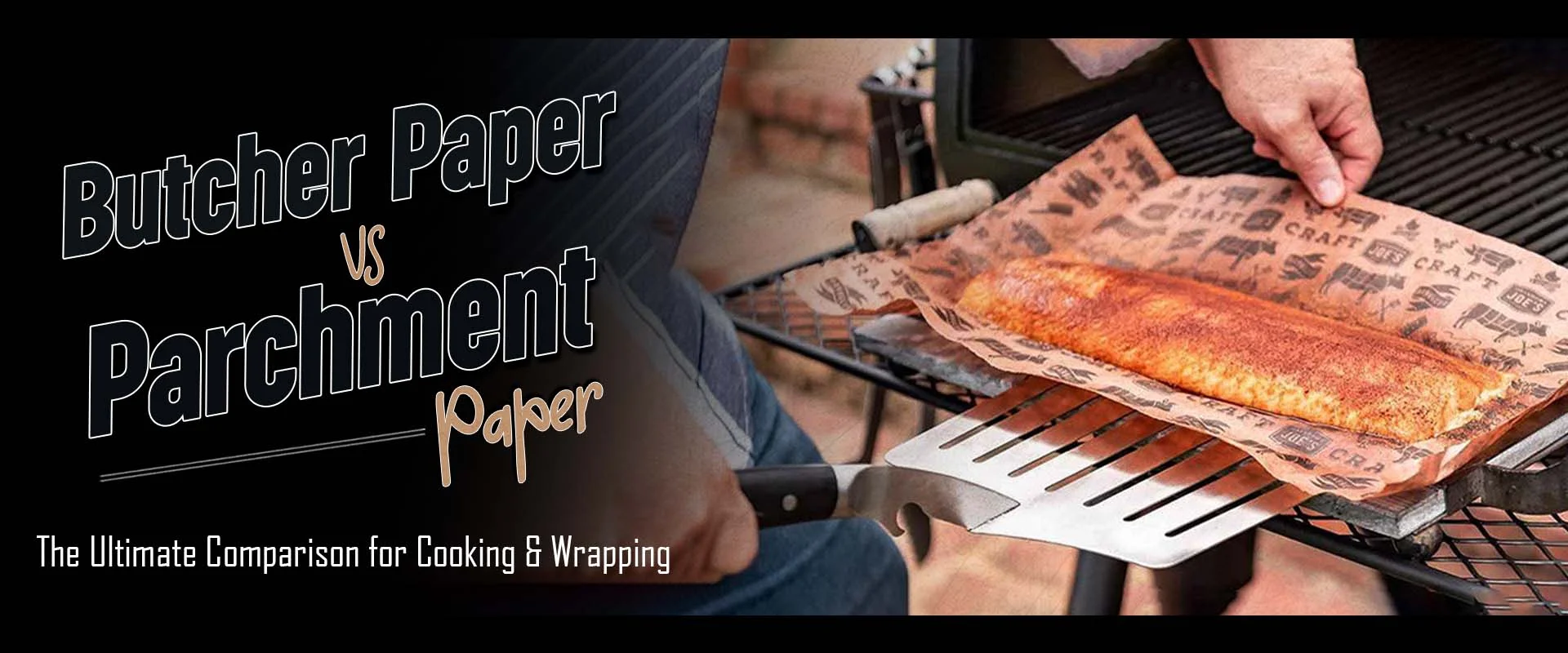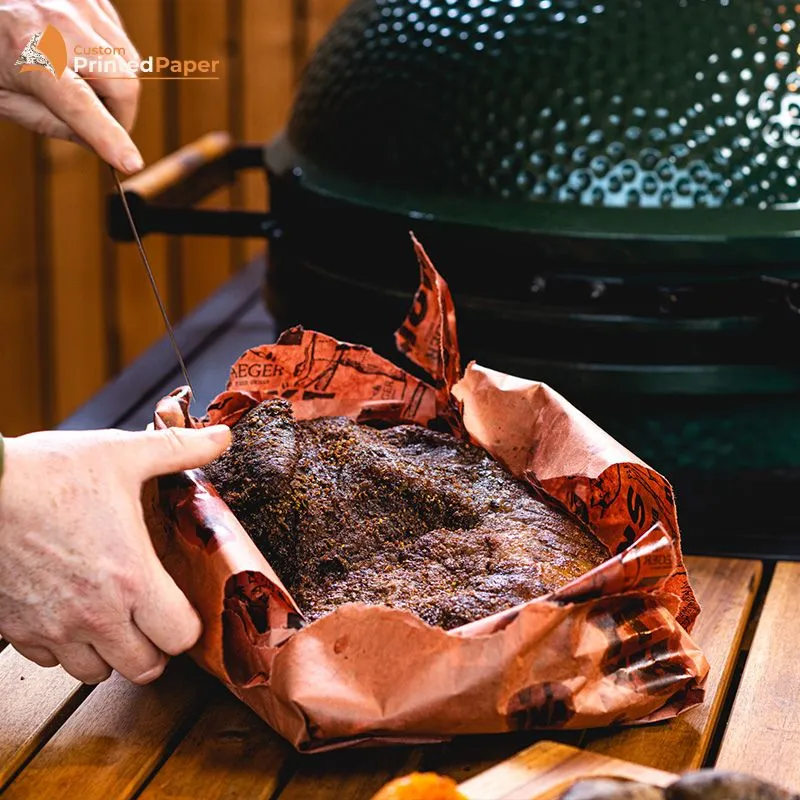
Parchment Paper vs Butcher Paper: The Ultimate Comparison for Cooking and Wrapping
October 24, 2024 Explore Blogs
Butcher’s paper and parchment are the most extensively used papers for cooking, wrapping, or saving food; Their distinct features make them fit for certain jobs but they cannot replace one another. If you want to make a knowledgeable decision concerning your own kitchen or trade, then learning the differences will help you.
This paper will delineate all the important features, uses, advantages, and dissimilarities between parchment paper and butcher paper so that you can know when and how to use them effectively. Custom printed options will be briefly discussed as they can help in elevating your food business brand.
What is Butcher paper?
Thick, robust paper that butchers typically utilize for wrapping meat is known as butcher paper. Nonetheless, its use has widened to include other functions such as cooking, packaging, and crafts among others.
Key Features of Butcher Paper:
Material: Made from Kraft pulp, custom butcher paper is sturdy and long-lasting.
Breathability: The texture of the material is porous, hence allowing air flow that helps maintain the fresh state of the meat.
Grease Resistance: Although it is not entirely free from grease, the butcher’s paper can resist moderate levels of grease.
Available in Multiple Colors: Typically, the paper is white, pink, or brown. It is specifically known that for barbecues a pink butcher paper is preferred.
Common Uses of Butcher Paper:
Wrapping Meat: It’s best for smoking raw or cooked meat, such as brisket, and maintaining the moisture.
Serving Food: Other than serving their intended purposes, they are used in restaurants and food trucks as a method of lining trays or wrapping sandwiches with butcher paper.
Packaging: In butcher shops and delis branding is often promoted by custom printed packaging.
Crafts: Because of its thickness, it is also definitely useful in arts and crafts.
What is Parchment Paper?
When we are baking and cooking, we utilize a specific kind of heat-resistant, non-stick paper. This paper is made more worthy of cooking pans or wrapping up meals thanks to its own silicon coating that stops the food from sticking to it. It is also useful in roasting and steaming since it possesses high-temperature endurance. It is also an easy-to-use and convenient method of disposal that allows for quick cleanup.

Key Features of Parchment Paper:
Non-stick Surface: It is coated with silicon so that food won’t stick to it when baking or roasting
Heat Resistance: When high temperatures cook, it resists a maximum of 450°F (232°C) which makes it perfect.
Greaseproof: Tom, an oil, fat, and water repellent, has unmatched excellence.
Compostable: Several various options of parchment paper are biodegradable and environmentally friendly.
Common Uses of Parchment Paper:
Baking: Lining baking sheets has never been easier; no more sticks on cookies, cakes or pastries.
Roasting Vegetables: This pan is an essential requirement for you if you wish to roast vegetables without adding excessive grease since it does not stick and can tolerate high temperatures.
Steaming Fish: Customarily used within the cooking method known as “en papillote,” fish or vegetables are sealed inside parchment paper, to be steamed in their juices.
Non-stick Surface for Candy Making: It provides a smooth surface for manipulating sticky substances such as warm chocolate or syrupy candies
Key Differences Between Butcher Paper and Parchment Paper
Whereas these two types of paper may appear to be similar, butcher paper is utilized for different ends and has a distinct production pattern as compared to the parchment kind. A detailed comparison is shown below:
| Feature | Butcher Paper | Parchment Paper |
|---|---|---|
| Material | Kraft paper (thick, durable) | Silicone-coated, heat-resistant paper |
| Primary Use | Wrapping meat, serving food | Baking, roasting, and cooking |
| Heat Resistance | Moderate (up to 300°F) | High (up to 450°F) |
| Greaseproof | Slightly grease-resistant | Fully greaseproof |
| Non-stick | No | Yes |
| Porosity | Breathable (helps retain moisture) | Non-porous |
| Custom Printing | Often available, great for branding | Rarely used for printing |
| Biodegradable | Yes | Often, yes |
When to Use Butcher Paper vs Parchment Paper
If you understand when to use butcher paper and when to use custom parchment paper, it will have a huge impact on your kitchen management and wrapping. A summary of these two papers’ optimal uses follows:
Butcher Paper:
Smoking Meat: Butcher paper helps preserve moisture and allows smoke to go through it when cooking brisket or other types of meat slowly.
Food Wrapping: Wrapping fresh meat and sandwiches is its greatest achievement.
Serving Tray Lining: The use of butcher paper has a rustic, charming touch that enhances the look of food trays.
Custom Branding: Custom-printed butcher paper takes your branding to another level if you are running a deli or restaurant.
Parchment Paper:
Baking: Most suitable for baking cookies, cakes, and pastries without the problem of sticking on the tray.
Roasting: Greaseproof and heat-proof, it’s best for roasting meats or vegetables that may discharge juices.
Steaming: Healthy cooking requires using parchment paper for steaming food in an oven like fish.
Non-stick Surface: Ideal for sticky materials such as confectionery or liquidized cocoa.
Pros and Cons of Butcher Paper vs Parchment Paper
Butcher Paper:
Pros:
- Able to breathe and hold moisture
- Lasts for a long time when wrapping and serving food.
- Automatic printing is available.
- Biodegradable and friendly to the environment.
Cons:
- Certainly, this does not guarantee full greaseproofness.
- This is not as heat resistant as plain paper.
- Not non-stick at all.
Parchment Paper:
Pros:
- Completely grease-proof, as well as non-sticky.
- Done for resistance against high temperatures as much as (up to) 450°F for one.
- Appropriate when it comes down to baking plus roasting operations.
- Compostable in most cases thereby classified as environmentally safe.
Cons:
- Not as long-lasting for wrapping meats.
- Not often available in custom print forms.
Custom Printed Options for Butcher Paper
Companies dealing with foods can take advantage of personalized butcher paper. For instance, it helps butchers, delicatessens, and mobile vending firms showcase their products better and maintain corporate identity.

Benefits of Custom Printed Butcher Paper:
Brand Visibility: people will see your name on every package they get out of the meat cutter’s paper that you supply them with
Professional Appearance: It implies a little more of a polished aspect which demonstrates functionality.
Eco-Friendly Options: A lot of eco-friendly options abound thanks to the many custom-printed butcher paper options made from recyclable materials for consumers.
Affordable Marketing: Businesses can be advertised at a low cost using such printed papers, which on top of that serve as good packaging materials.
Final Thoughts: Choosing the Right Paper for Your Needs
There is no trustworthy victor in this issue of parchment as opposed to butcher paper – this is because both types of paper have their benefits depending on what you are looking for. Parchment paper has no stick characteristics, it doesn’t allow grease to penetrate through it, and can withstand heat hence, it is suitable for baking, roasting, or steaming activities.
Butcher’s paper on the other hand is best for wrapping meats specifically; also it serves food and has custom printed paper options for branding purposes. When you know the unique features plus usages of butcher paper and parchment paper, you will make wise choices in your kitchen or company.
